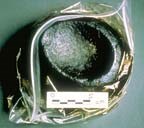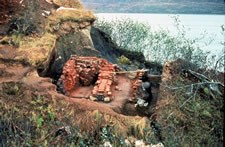
 Injury
Injury
The oil spill area is believed to contain more than 3,000 sites of archaeological and historical significance. Twenty-four archaeological sites on public lands are known to have been adversely affected by cleanup activities or looting and vandalism linked to the oil spill. Additional sites on both public and private lands were probably injured, but damage assessment studies were limited to public land and not designed to identify all such sites.
Documented injuries included theft of surface artifacts, masking of subtle clues used to identify and classify sites, violation of ancient burial sites, and destruction of evidence in layered sediments. In addition, residual oil may have contaminated sites.
Recovery Objective
Archaeological resources are nonrenewable: they cannot recover in the same sense as biological resources. Archaeological resources will be considered to have recovered when spill-related injury ends, looting and vandalism are at or below pre-spill levels, and the artifacts and scientific data remaining in vandalized sites are preserved (e.g., through excavation, site stabilization, or other forms of documentation).
Recovery Status
Assessments of 14 sites in 1993 suggested that most of the archaeological vandalism that can be linked to the spill occurred early in 1989, before adequate constraints were put into place over the activities of oil spill cleanup personnel. Most vandalism took the form of "prospecting" for high yield sites. Once these problems were recognized, protective measures were implemented and successfully limited additional injury. Although some cases of vandalism were documented in the 1990s, there appears to be no spill-related vandalism at the present time.
 From 1994-1997, two sites in Prince William Sound were partly documented, excavated, and stabilized by professional archaeologists because they had been so badly damaged by oiling and erosion. The presence of oil in sediment samples taken from four sites in 1995 did not appear to have been the result of re-oiling by Exxon Valdez oil. Residual oil does not appear to be contaminating any known archaeological sites.
From 1994-1997, two sites in Prince William Sound were partly documented, excavated, and stabilized by professional archaeologists because they had been so badly damaged by oiling and erosion. The presence of oil in sediment samples taken from four sites in 1995 did not appear to have been the result of re-oiling by Exxon Valdez oil. Residual oil does not appear to be contaminating any known archaeological sites.
In 1993, the Trustee Council provided part of the construction cost for the Alutiiq Archaeological Repository in Kodiak. This facility now houses Kodiak area artifacts that were collected during spill response. In 1999, the Trustee Council approved funding for an archaeological repository and local display facilities for artifacts from Prince William Sound and lower Cook Inlet.These are currently in various stages of construction.
Based on the apparent absence or extremely low rate of spill-related vandalism and the preservation of artifacts and scientific data on archaeological sites and artifacts, archaeological resources are considered to be RECOVERED.
Click HERE for more information on Trustee Council funded Archaeological Resources studies.
